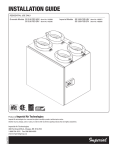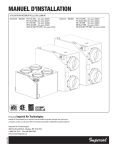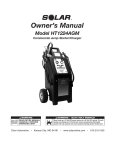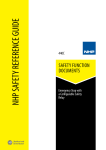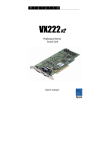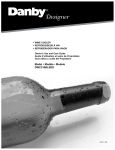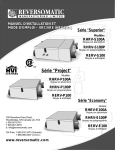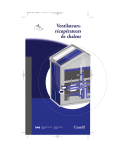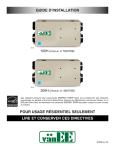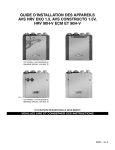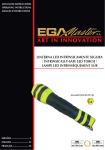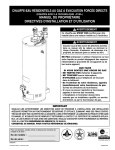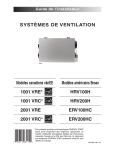Download INSTALLATION GUIDE
Transcript
Installation Guide gp d. su n w ay in fo . co m .cn Greentek Models SS 3.80 FSD HRV(Item No. 102208) SS 3.80 FSD ERV (Item No. 102210) Imperial Models SS 3.80 FSD HRV(Item No. 102257) SS 3.80 FSD ERV (Item No. 102259) Product of Imperial Air Technologies Imperial Air technologies Inc. reserves the rights to modify a product, without prior notice, whether in price, design, color or codes, in order to offer at all times quality products that are highly competitive. Item# 102337 Imperial Air Technologies 480 Ferdinand Blvd., Dieppe, NB E1A 6V9 1-888-724-5211 Fax 506 388-4633 www.imperialgroup.ca Page 2 gp d. in ay w su n .cn m co fo . important - Please read manual before installation Caution: Do not install in a cooking area or connect directly to any appliance. Turn off all integral disconnects before servicing. Notice: Prior to installing, serious consideration must be taken to insure this ventilation system will operate properly if integrated to any other type of mechanical system, i.e. a forced air system, or an air handling unit. To insure proper operation & compatibilities of both system, it is required that the airflow’s of the Heat Recovery Ventilator (HRV) or Energy Recovery Ventilator (ERV) be balanced, by following the procedures found in this manual. Limitations: The product is for residential applications only. Must be installed in accordance with all national and local regulations, building and safety codes. to reduce or avoid the hazards of electric shock and fire: cautions concerning the operation and full efficiency of this product: • Use a dedicated AC 120V outlet only. • Before servicing or cleaning the HRV system, always remove the power cord from the AC wall outlet. • Do not obstruct or cover the air intake or air outlet of the ventilation system. • To reduce the hazards of electric shock or fire, do not perform any service to the HRV system other than those stated in the operating manual instructions. • Do not modify, repair or disassemble this system. These tasks are to be performed by authorized serviced personnel only. Fire, electrical shock and/or bodily injury may occur if these warnings are not followed. • To reduce the risk of electric shock, this ventilation system (HRV/ERV) comes equipped with a 3-prong plug-in. This plug will fit in a polarized outlet only one way. • To prevent injuries, do not operate the ventilation system, while servicing or maintaining. There are impeller wheels turning at a very high speed that must fully stop rotating prior to accessing the inside of the unit. • Do not use ventilation system for outdoor application. • Do not pull or twist power cord when disconnecting it from the ventilation system. Grasp the plug firmly, not the cord. • Always assess the operation of the ventilation system on how it may interact with vented combustion equipment (ie. Gas Furnace, Oil Furnace, Combustion, Appliances, etc.) • Do not modify the power plug in any way; if modified, risk of electric shock fire or even damage to the unit may occur. • Do not use the ventilation system for removal of flammable fumes, gases or connect directly to any appliances. fo . co m .cn • Do not use for swimming pool/spa applications. ay in About Us su n w Imperial Air Technologies Inc. is the only manufacturer that offers you a complete range of products designed to improve indoor air quality, and that provides a wide selection of accessories to facilitate installation. d. Our vision – To offer a complete range of products that satisfies environmental concerns. gp Whether your needs involve ventilation or filtration, we have the customized solution for you, with its range of quality products backed by the best warranty in the industry. Contents section Page 1. Performance & Specifications . . . . . . . . . . . . . . . . . . . . . . . 4 2. Ventilation requirements . . . . . . . . . . . . . . . . . . . . . . . . . . 5 3. Types of Installations . . . . . . . . . . . . . . . . . . . . . . . . . . .5-6 4. Installation Kit . . . . . . . . . . . . . . . . . . . . . . . . . . . . . . . . 7 5. Finding a suitable installation area for HRV or ERV . . . . . . . . . . 7 6. Installation of the HRV / ERV . . . . . . . . . . . . . . . . . . . . . . . . 7 7. Insulated Flex from Unit to Outside Wall . . . . . . . . . . . . . . . . . 8 8. Condensation Drain Line . . . . . . . . . . . . . . . . . . . . . . . . . . 8 9. Dedicated Electric Receptacle . . . . . . . . . . . . . . . . . . . . . . 8 10. Outside Fresh Air and Exhaust Air Hoods . . . . . . . . . . . . . . . 9 11. The matrix™ High Performance Ventilation Hood . . . . . . . . . . . 9 12. Benefits of the Duotrol™ System . . . . . . . . . . . . . . . . . . . . 10 13. Balancing the unit . . . . . . . . . . . . . . . . . . . . . . . . . . . 10-11 14. Controls Connection . . . . . . . . . . . . . . . . . . . . . . . . . 12-13 15. Wiring Diagrams for furnace interlock systems . . . . . . . . . . . 13 16. Troubleshooting . . . . . . . . . . . . . . . . . . . . . . . . . . . . . . 14 17. Maintenance . . . . . . . . . . . . . . . . . . . . . . . . . . . . . . . . 14 Page 3 1. Performance & Specifications Ventilation Performance HRV SS 3.80 FSD Net Supply Air Flow L/s CFM 47 99 44 93 39 83 35 75 30 65 27 56 22 46 Gross Air Flow Supply L/s CFM 48 100 45 94 40 84 35 75 30 66 27 57 22 47 Gross Air Flow Exhaust L/s CFM 48 102 43 92 38 80 36 78 32 68 25 52 19 41 ▲ Supply ■ Exhaust in wg (Pa = n x 248.36) External Static Pressure Pa in. wg 25 0.1 50 0.2 75 0.3 100 0.4 125 0.5 150 0.6 175 0.7 cfm (L/s = n x 0.4719) Ventilation Performance ERV SS 3.80 FSD Net Supply Air Flow L/s CFM 49 105 46 97 44 92 37 80 34 73 29 62 23 48 Gross Air Flow Supply L/s CFM 49 105 47 99 44 93 38 81 35 74 29 63 23 49 Gross Air Flow Exhaust L/s CFM 46 97 41 86 41 86 34 73 29 63 25 52 18 37 ▲ Supply ■ Exhaust in wg (Pa = n x 248.36) External Static Pressure Pa in. wg 25 0.1 50 0.2 75 0.3 100 0.4 125 0.5 150 0.6 175 0.7 .cn cfm (L/s = n x 0.4719) Energy Performance ERV SS 3.80 FSD Supply Net Power SensibleApparent Temperature Air Flow Consumed Recovery Sensible °C °F L/sCFM Watts Efficiency Effectiveness 032 19 40 28 64 72 032 30 65 40 59 66 -25-13 18 37 30 55 73 Supply Net Power SensibleApparent Temperature Air Flow Consumed Recovery Sensible °C °F L/sCFM Watts Efficiency Effectiveness 032 20 41 30 65 74 032 30 65 36 64 71 -155 16 35 27 54 80 This product earned the ENERGY STAR® by meeting strict energy efficiency guidelines set by Natural Resources Canada and the US EPA. It meets ENERGY STAR requirements only when used in Canada. SPECIFICATIONS HEATING Total Recovery Efficiency 3595 19 41 43 COOLING gp d. HEATING su n w ay in fo . co m Energy Performance HRV SS 3.80 FSD HRV SS 3.80 FSD Size 20" x 14 ⁄2" x 18" Weight 33.5 lbs (15.2 Kg) CFM 30 to 100 Type of heat exchanger cross-flow (Polypropylene) Exchange surface 65 ft2 Voltage 120 VAC @ 60 Hz Amperage 0.85 A Defrost typeEvacuation Certification CSA / HVI / Energy Star Shipping Weight 41 lbs (18.6 Kg) 1 ERV SS 3.80 FSD 20" x 14 1 ⁄2" x 18" 32.5 lbs (14.7 Kg) 30 to 100 cross-flow (Enthalpy) 65 ft2 120 VAC @ 60 Hz 0.85 A Evacuation CSA / HVI 40 lbs (18.1 Kg) Dimensions 5" 18" 2 51 ⁄64" 20" Page 4 14 1 ⁄2" 2. Ventilation requirements Determine Your Ventilation Needs installation A. Room Count Calculation LIVING SPACENumber of Rooms Master Bedroom How much fresh air do I need? Good air quality is based in part on the capacity of the home’s ventilation system. With Basement Usually, the HRV’s/ERV’s capacity is measured in CFM (Cubic Feet per Minutes) or L/s (Liters per Seconds) of fresh air being distributed in the living space. The Room Count Calculation or the Air Change per Hour Method shows you how to determine your ventilation needs.(see chart on right) Dinning Room Single Bedroom Living Room Family Room Recreation Room Other Kitchen Bathroom Laundry Room Utility Room CFM (L/s) CFM Required ———— ———— x 20 cfm (10 L/s) = ———— x 20 cfm (10 L/s) = ———— ———— ———— x 10 cfm (5 L/s) = ———— x 10 cfm (5 L/s) = ———— ———— ———— x 10 cfm (5 L/s) = ———— x 10 cfm (5 L/s) = ———— ———— ———— x 10 cfm (5 L/s) = ———— x 10 cfm (5 L/s) = ———— ———— ———— x 10 cfm (5 L/s) = ———— x 10 cfm (5 L/s) = ———— ———— ———— x 10 cfm (5 L/s) = ———— x 10 cfm (5 L/s) = ———— TOTAL ventilation requirement (add last column) = ———— 1 CFM = 0.47189 L/s 1 L/s = 3.6 m3/hr m d. su n w ay in fo . A 25’x 40’ house with basement 1,000 Sq. ft. x 8’ high x 2(1st floor + basement) = 16,000 cu. ft. 16,000 cu. ft. x 0.35 ACH = 5,600 cu. ft. 5,600 cu. ft. / 60 Minutes = 93.3 CFM 93.3 CFM is your ventilation need gp Example: co TOTAL cu ft X 0.35 per hr = total Take total and divide by 60 to get CFM .cn B. Air Change per Hour Method 3. Types of Installations Independent System installation figure 3.1 This application uses a devoted duct system for the supply and the exhausting of stale air accumulated in the home. It is recommended to install fresh air grilles in all bedrooms and living areas. Exhaust the stale air from the bathroom, kitchen and laundry room. (see figure 3.1) Important: For optimal performance of your HRV or ERV, the installation of an optional 6” round galvanized backdraft damper is required on the fresh air to home duct work. Page 5 3. Types of Installations (continued) Exhaust at the source and supply in the return figure 3.2 This application uses a devoted duct system for the exhausting of stale air accumulated in the home. The fresh air is dumped into the return air duct and is distributed thru the home by the existing supply air ductwork of the forced air system. (see figure 3.2) From Bathroom or Kitchen To living space Minimum 10' (3 m) 6' (1.83 m) Make sure when using this application that your fresh air duct connection to the forced air system return air duct is at a minimum of 10ft (3 m) from the forced air system. You should check with your local code or the forced air system’s manufacturer. 18" (457 mm) HRV / ERV Forced Air System The forced air system’s blower does not essentially have to run when the unit is in continuous mode, but recommended for maximum efficiency. *For minimum distance between return and forced air system, check with your local building codes and forced air system manufacturer. CAUTION: Insure the unit runs in conjunction with forced air system (Ref section 14) Supply air from HRV/ERV must be at least a minimum of 10ft (3 m) from the forced air system. Can be different from a region to an other. You should check with your local code or the forced air system’s manufacturer. w su n 6' (1.83 m) To living space Forced Air System HRV / ERV *For minimum distance between return and forced air system, check with your local building codes and forced air system manufacturer. Important: Building and combustion appliance installation codes do not allow return air grilles or openings such as "breather tee" or indirect connections in an enclosed room that is susceptible to spillage of combustion appliances. Simplified Connection Indirect Connection 2" (51 cm) Page 6 Minimum 10' (3 m) 18" (457 mm) CAUTION: The HRV and forced air system must be in continuous mode, to achieve maximum comfort and to avoid cross-contamination. Important: For optimal performance of your HRV or ERV, the installation of an optional 6" round galvanized backdraft damper is required on the fresh air to home duct work. 6' (1.83 m) d. When using this application make sure that there is minimum 6 feet between the fresh air and exhaust air connections of the HRV/ERV in the return air duct. (see figure 3.3) figure 3.3 gp Exhaust and supply in the return ay in fo . co m .cn Note to installer: Dwellings with multiple forced air systems requires one HRV/ERV per system. Breather Tee 4. Installation Kit Included in the installation kit: figure 4.1 • 4 Collars • 4 Caps, Pressure Taps (9753K74) • 1 Condensation Drain Line • 1 Drain Adapter with Nut • 12 screws (#10 x 11/4”) • 2 screws (#8 x 3/8”) • AC 120V power cord • Wall Mounting Bracket 5. Finding a suitable installation area for HRV or ERV The HRV/ERV unit should be installed in a mechanical room or as close to an outside wall as possible. This would assure a short run of insulated flexible duct. .cn The HRV/ERV unit must always be installed in an area where the air is tempered to avoid freezing of the condensate line. The contractor should install the unit in an area that is very accessible to allow the homeowner easy access for maintenance. in fo . co m It is very important to install an electric receptacle (115v) near the HRV / ERV, a separate circuit breaker is also recommended. You should have access to a condensate drain near the HRV/ERV to avoid the use of condensate pump. w su n d. A) Minimum two 2"x 4" (50.8 mm x 101.6 mm) wood wall studs and minimum 3⁄8 " (9.5 mm) thick drywall is required to secure the HRV/ERV wall bracket. gp IMPORTANT Minimum installation requirements ay 6. Installation of the HRV / ERV B) Support for weight of 80 lbs, which includes HRV/ERV, duct connections and accessories. Proper installation requires that the unit be secure to the wall. If there is no wall studs available, please secure a 3 ⁄4" plywood to wall studs then fasten wall mounting bracket to plywood. figure 6.1 Installation of the wall bracket. Secure with two #10 x 11⁄4" screws. tip to installer: If the unit is not level, improper drainage will occur and could lead to moisture and leakage problems. It is recommended to use approximately 16 inches of flexible duct between the HRV/ERV and your rigid duct. The flex duct is mounted the same way to the HRV/ ERV as the insulated flex. figure 6.2 Hang HRV/ERV to wall mounting bracket. figure 6.3 When completing the procedure make sure that the HRV/ERV is leveled. figure 6.4 Proceed to secure HRV/ERV to bracket with the two #8 x 3⁄8 " screws. Page 7 7. Insulated Flex from Unit to Outside Wall tip to installer: To ensure a better installation and to avoid an undesired bend in the duct, align the duct with the collar before securing over the four hooks. Warning: Always fix and secure the 5" collars with the screws supplied. Avoiding this critical step the unit will figure 7.1 Insert vinyl duct over the hooks accumulate condensation. and seal with a Tie wrap. figure 7.2 Insert insulation inside the collar. figure 7.3 Finish by taping the duct on the collar. m .cn Once insulated flex is attached to the collar, slide collar in keeper section, fixed collar to the unit with four screws supplied in installation kit. Figure 7.5 Fix and secure the collars to the HRV/ ERV with the #10 x 11⁄4" screws, supplied in kit. in fo . co figure 7.4 Slide collar on the unit. su n w ay 8. Condensation Drain Line gp d. Insert the threaded drain adapter thru the bottom of the HRV/ERV and hand tighten the plastic nut, and with a wrench tighten the nut another half turn to assure a better seal. Install the condensate line (included in drain kit). Insert condensate tubing by pushing clear plastic line over drain adapter. Make condensate trap by looping the clear plastic tubing. This procedure is to avoid foul odor to enter the HRV or ERV. figure 8.1 Make a loop in condensate line, not be subject to freezing temperatures. 9. Dedicated Electric Receptacle IMPORTANT: Always consult a certified technician to insure proper installation of main power. Note: If LED light on the Duotrol remains green, motors not energized controls do not operate. Polarization in main AC outlet are inverted. It is recommended that the HRV/ ERV have a dedicated receptacle with 115v. It is not recommended to connect unit with an extension cord. Page 8 figure 9.1 Insert the power cord on top of the unit. Press firmly to make sure the power cord is secure. figure 8.2 Use a condensate pump if you don’t have access to a drain. 10. Outside Fresh Air and Exhaust Air Hoods tip to installer: We recommend and it is good practice to have a minimum of 6ft (1.83 m) between the supply and exhaust vents, unless using a concentric vent design to prevent contamination of intake air. 6ft (1.83 m) Note: Outdoor air intake hoods shall be located to avoid contamination from sources such as: • Exhaust air openings • Driveways (auto exhaust) 18" (457 mm) • Combustion appliances • Gas meters, oil fill pipes • Garbage containers • Attics or crawl spaces • Under deck or other areas of questionable air quality figure 10.1 Locating Outside Hoods Important: Always consult your national and local regulations, building and safety codes. Airflow & Installation m .cn 11. The matrix™ High Performance Ventilation Hood Exhaust air from home “TOP” fo . co Exterior wall w ay in IMPORTANT: Install ventilation hood a minimum of 18” (457mm) above grade. Fresh air to home “BOTTOM” gp d. su n Do not install under a deck, enclose porch, patio, garages, crawl spaces or attics. WARNING: Insure the ventilation hood is at a minimum clearance of 6 ft (1.83 m) away from the exhaust vents of a combustion source and contaminants. Exhaust air to outside Ex: Gas furnace, dryer, gas boilers, range hoods, barbecue, garbage bin, driveway or garage. Ventilation cap Uniquely design individual insulated transition duct (UL 94 Rated) Transition connector plate Important: Always consult national and your local regulations, building and safety codes. Limitation: This product is for residential applications only. Fresh air from outside Airflow Performance Data Supply Air Flow Performance 0.25 External Static Pressure in wg (Pa = n x 248.36) Limitations: This product is for residential applications only. Must be installed in accordance with all current national and local regulation building and safety codes. Exhaust Air Flow Performance 0.25 External Static Pressure in wg (Pa = n x 248.36) Airflow Performance Data 0.2 0.15 0.1 0.05 0 30 45 60 75 90 CFM (L/s = n x 0.4719) 105 120 0.2 0.15 0.1 0.05 0 30 45 60 75 90 105 120 CFM (L/s = n x 0.4719) Limitations: This product is for residential applications only. Must be installed in accordance with all current national and local regulation building and safetyPage codes. 9 12. Benefits of the Duotrol™ System Mode Selector Acts as a mode selector • Intermittent Intermittent: When the selector switch is in the intermittent position the HRV/ERV will only run when there is a call for ventilation by any control. At that time the unit will run on high speed until the condition is satisfied. • Continuous • Off Continuous: When the selector switch is in the continuous position the HRV/ERV will run continuously on pre set speed except when there is a call for override by any control. Off: When the selector switch is in the off position the HRV/ERV will not come on even if there’s a call for ventilation by any control. Speed Adjustment + Button: Increase the speed of the selected motor. • Increase Speed ( + ) – Button: Decrease the speed of the selected motor. • Decrease Speed ( – ) m co Using the Selector Switch fo . tip to installer: When on Balancing Mode, the Selector Switch allows you to choose the motor you want to set. 2. CONT (Both Motors) d. 1. INTER (Exhaust Motor) su n A) Closed Duotrol Cover gp GREEN LIGHT Mode Selector w ay in with the Duotrol™ System .cn 13. Balancing the unit 3. OFF (Supply Motor) Page 10 Duotroltm Balancing system YELLOW LIGHT Balancing Mode Procedures, Steps 1 through 8. B) Open Duotrol Cover 1. UP (Exhaust Motor) 2. MIDDLE (Both Motors) 3. DOWN (Supply Motor) Step 1: Press the (+) and (–) buttons simultaneously until you see the yellow light. Once the indicator light turns yellow you are in balancing mode. Step 5: Then perform the same operation on the stale air side by selecting the «INTER» position on the DuotrolTM. Step 2: When in balancing mode the selector switch becomes the motor selector switch. INTER (Right Motor), CONT (Both Motors) and OFF (Left Motor) Step 6: The «CONT» position will allow you to adjust the cfm on both motors proportionately (if necessary). Step 3: Once the total cfm needed is determined, you can start balancing the HRV/ERV. Set your fresh air supply by selecting the «OFF» position on the Duotrol TM. Install your magnehelic gauge and air flow grid in the fresh air duct. Step 7: Once this is completed, you have set the high speed on your HRV/ERV. To lock balancing mode you must press (+) and (–) buttons simultaneously and release. The indicator light will turn green to indicate normal operation mode. Step 4: Press the (–) button to decrease the cfm or press the (+) button to increase the cfm. Step 8: Once high speed is set and locked, switch to continuous on the Duotrol TM. By using (+) and (-) buttons set low speed on the HRV/ERV. 13 Balancing the unit (continued) with the Duotrol system and the integrated balancing taps and Magnehelic gauge. HIGH (Exhaust Air to Outside) LOW (Exhaust Air from Home) Magnehelic gauge Balancing Tap Connection* Magnehelic gauge HIGH (Fresh Air to home) LOW (Fresh Air from Outside) Connecting the Magnehelic gauge to the collar balacing taps, then proceed to section 13 (on page 10) Duotrol tm Balancing System Procedures and follow the Steps 1 through Step 8. ay w su n d. gp Note: To perform a proper install, the External Static Pressure (ESP) needs to be measured at each of the 4 stations. Then proceed to measure the Delta P(DP) to determine the corresponding airflow (e.g. 50 CFM), then do the iteration until the unit is balanced both the (ESP and airflows). Fresh Air L/s 44 41 39 37 35 33 30 29 26 24 22 19 17 m co Pressure Pa in. wg 50 0.20 62 0.25 75 0.30 87 0.35 100 0.40 112 0.45 125 0.50 137 0.55 150 0.60 162 0.65 175 0.70 187 0.75 199 0.80 .cn Balancing Chart when using collar pressure taps. in The balancing chart is based on a Delta P (DP) measurement (also located on the access panel of the ventilation system) fo . balancing chart CFM 93 87 83 79 74 69 65 61 56 50 46 41 36 Exhaust Air L/s CFM 43 90 40 85 37 79 36 77 36 76 34 71 32 67 28 60 24 51 22 47 19 41 17 36 15 31 *Important: Once balancing is complete, insure all four pressure taps are sealed with the rubber caps. Pressure taps (9753K74) supplied in the installation kit. with an airflow grid & Magnehelic Gauge Magnehelic Gauge with Air Flow Grid Inserting Air flow grid in duct Seal Air flow grid in duct with duct tape. Page 11 14. CONTROLS CONNECTION RD-1 (2 wires) G G R G R B G W B W R R RD-2, RD-3P, RD-4P (4 wires) .cn R R G G B B W W B G R B G R Vectouch (4 wires) m Jumper Jumper JP-4* JP-4* in ay w su n 2 Relays 2 Relays d. * Jumper JP-4 "ON" offers (Intermittent and Continuous modes) P, RNC, SS3.12 FSD, SS3.80 FSD and the LCH Series. * Jumper JP-4 "OFF" offers (Intermittent, Recirculation and Continuous modes) model DH and the SS3.12DD Series only. LVC Version 1 LVC Version 1 fo . co NOTE: With LVC version 1 it is normal that the wall control LCD panels doesn't turn off when the Duotrol on the unit is in the "OFF" position. gp RB G BW G BR RG RW B G To Casing Screw ToGround Casing for Screw for Ground Jumper Jumper JP-4* JP-4* Jumper Jumper JP-4* JP-4* LVC LVC Version Version 1 1 LVC Version 2 LVC Version 2 2 2 Relays Relays R RW W B B G G To To Casing Casing Screw Screw for Ground Ground for 1 Relay 1 Relay RW B G RW B G Jumper Jumper JP-4* JP-4* LVC LVC Version Version 2 2 CAUTION: Minimum wire requirements is LVT18 CSA/UL 4 strain to insure proper connection. Page 12 1 1 Relay Relay 14. CONTROLS CONNECTION (continued) T3 Timer (3 wires) B G R 15. Wiring Diagrams for furnace interlock Jumpersystems 24 VAC 5 VDC 2 Relays m .cn RW B G co 5 VDC Low Voltage HRV Controller Force Air System ay in A relay is normally used when tying a ventilation system to the forced air distribution system. Our Duotrol System is equipped with an internal relay that will activate the forced air system’ ventilator when there is a demand from the HRV /ERV. The Duotrol System will activate the INTERLOCK relay during the following modes: Continuous, To Casing Screw Override,Recirculation and Defrost. for Ground See wiring diagram. LVC Version 1 JP-4* fo . Standard Forced Air Interlocking Wiring w Legend: -------- Field Installed Low Voltage su n Figure 15.1 Standard forced air wiring diagram Some forced air system thermostat will activate the cooling system when tied using the «Standard forced air interlocking wiring». If you have identify this type of thermostat you must proceed with the «Alternate Forced Air Wiring». Jumper JP-4* d. gp Alternate Forced Air Interlocking Wiring 24 VAC LVC Version 2 5 VDC 1 Relay RW B G 5 VDC Locating the Wiring Diagram Note to installer: Wiring Diagram for the entire line of HRV/ERV Models are placed on the back of each Exhaust motor bracket. CAUTION: Thermostat that control A/C system must use the Alternate Interlock Wiring Diagram. Force Air System Low Voltage HRV Controller *Before tying the HRV/ERV to a forced air system, always refer to system’s manual or manufacturer. Thermostat Legend: -------- Field Installed Low Voltage Figure 15.2 Alternate forced air wiring diagram Warning: Always disconnect the unit prior to making any connections. Failure to disconnecting the power could result in electrical shock or can damage the electronic boards, wall controls and/or unit. CAUTION: Minimum wire requirements is LVT18 CSA/UL 4 strain to insure proper connection. Page 13 16. Troubleshooting Need help? You benefit from certified customer service ready to guide you in the installation or operation of your system. Call Toll free: 1 888 724-5211 PROBLEMSSOLUTIONS • HRV/ERV not running • Verify polorization • Verify breaker in electrical box • Verify that dehumidistat or switch on HRV/ERV are activated to supply power to unit. • Unplug HRV/ERV verify if controller is wired correctly to the connection box on the side of the unit. • Verify low voltage box (Duotrol TM )on the unit Accessories • Air is too dry • Increase humidity level on dehumidistat. Using the appropriate accessories, your system will be simple to install and its performance will be optimal. • Switch ventilation mode from continuous to intermittent • Install a humidifier •Air too humid • Reduce the humidity level on the controller. • Verify if dryer is venting in basement. • Verify if heating wood is stored in basement. Choose from the complete range of ventilation accessories and products by “Imperial Air Technologies Inc”. • Wait for outside temperature to change. Ex. Summer can be extremely humid. • Verify balancing of the HRV or ERV. .cn ay in fo . co m 17. Maintenance su n d. gp When should I Service my HRV/ERV? w Warning: ALWAYS UNPLUG HRV/ERV DURING SERVICING HEAT RECOVERY & Energy recovery CORE UNIT Once a year or as needed, vacuum the four surfaces, let soak in warm water for 15 minutes, then spray rinse and let dry. figure 17.1 Slide Out the Filters FILTERS Four times a year or as needed, vacuum the filters. Replace filters once a year. INSIDE THE UNIT Once a year or as needed, vacuum all surfaces inside the unit. figure 17.3 Slide out the Core Page 14 figure 17.2 Vacuum the Filters gp d. in ay w su n .cn m co fo . NOTES Page 15 .cn m co fo . in ay w su n d. gp Item# 102337 Imperial Air Technologies 480 Ferdinand Blvd., Dieppe, NB E1A 6V9 1-888-724-5211 Fax 506 388-4633 www.imperialgroup.ca gp d. in ay w su n .cn m co fo . Item# 102337 Imperial Air Technologies 480 Ferdinand Blvd., Dieppe, NB E1A 6V9 1-888-724-5211 Fax 506 388-4633 www.imperialgroup.ca gp d. in ay w su n .cn m co fo . Page 15 NOTES 16. Dépannage Besoin d'aide? Bénéficiez d'un service à la clientèle assuré par du personnel certifié et prêt à vous guider dans l'installation ou l'utilisation de votre système Greentek MD. Sans frais: 1 888 724-5211 Accessoires Avec les accessoires appropriés, l'installation de votre système se fera en toute simplicité et en améliorera son rendement. Choisissez parmi la gamme complète d'accessoires et de produits de ventilation « Imperial Air Technologies Inc ». PROBLÈMESSOLUTIONS • VRC/VRE ne fonctionne pas • Vérifier le disjoncteur dans le panneau électrique • Vérifier que l’interrupteur du déshumidistat et de la boite de contrôle sur le VRC/VRE sont en position apport de courant à l’unité. • Réduiser le niveau d’humidité sur le module de contrôle • L’air est trop humide • Installer un humidificateur • Changer le mode de ventilation du mode continu à intermittent • Augmenter le niveau d’humidité sur le déshumidistat • L’air est trop sec • Vérifier l’ampérage des moteurs • Vérifier si le courant atteint la boîte de connexions (bas voltage) • Vérifier si le courant atteint le transformeur • Débrancher le VRC/VRE et vérifier si le module de contrôle est bien branché à la boîte de connexions sur le côté de l’unité • Vérifier si du bois de chauffage est entreposé dans le sous-sol • Vérifier si la sécheuse évacue dans le sous-sol • Attendre que la température extérieure change (ex. En été, la température peut être extrêmement humide) • Vérifier le balancement du VRC/VRE gp d. in ay w su n 17. Maintenance fo . .cn m co AVERTISSEMENT: TOUJOURS DÉBRANCHER TOUT APPAREIL ÉLECTRIQUE AVANT L’ENTRETIEN. Quand devrais-je entretenir mon VRC/VRE ÉCHANGEUR THERMIQUE Une fois par année ou au besoin, nettoyer les quatre surfaces avec l'aide d'un aspirateur et laisser tremper dans de l'eau tiède savonneuse pour environ trois heures, rinser et laisser sécher. figure 17.1 Enlever les filtres figure 17.2 Nettoyer à l’aide d’un aspirateur FILTreS Quatre fois par année ou au besoin, nettoyer les filtres avec l'aide d'un aspirateur. Remplacer les filtres une fois par année. INTÉRIEUR DE L’UNITÉ Une fois par année ou au besoin, nettoyer l'intérieur de l'appareil figure 17.3 Glisser l’échangeur thermique vers l’extérieur Page 14 14. Contrôles et branchement (suite) Minuterie T3 (3 fils) B G R 15. Diagramme de raccordement avec système Jumpeur à air forcé LVC Version 1 JP-4* Raccord standard avec un système à air forcé 24 VAC 5 VDC gp Un relais est normalement utilisé pour raccorder un système de ventilation à un système à air forcé. Notre 2 Relais système DuotrolMD est doté d’un relais intégral qui permet de commander le RW B G démarrage du ventilateur du système à air forcé lors d’une demande provenant du VRC/VRE. Le système DuotrolMD du VRC/VRE active Viserlea une vis relais INTERLOCK pendant les modes cabinet d’opérations suivants : ducontinu, pour la Contrôle à voltage bas de VRC/VRE demande, recirculation et dégivrage. prise de terre. Voir diagramme de branchement ciLégende : -------- Ligne installée à voltage bas contre. d. ay w su n 5 VDC in Système à air forcé co fo . .cn m Figure 15.1 Raccord standard avec un système à air forcé Raccord auxiliaire avec un système à air forcé Certains thermostats du système à air forcé branché avec le raccord standard ci-dessus vont activer le système de climatisation. Lorsque vous identifiez ce type de thermostat, veuiller procéder avec l’installation à raccord auxiliaire avec un système à air forcé. Jumpeur JP-4* LVC Version 2 24 VAC 5 VDC 1 Relai RW B G Localiser l’emplacement du diagramme de branchement Note à l’installateur : Le diagramme de branchement pour tous les modèles Professionnel, De Luxe , séries SS3,12 et SS3,80 sont localisés à l’intérieur du bras de support sur le moteur d’évacuation. 5 VDC Système à air forcé Contrôle à voltage bas de VRC/VRE *Toujours ce référer aux spécifications du manufacturier avant de raccorder un VRC/VRE à un système à air forcé.. Thermostat Legend: -------- Ligne installée à voltage bas Figure 15.2 Raccord auxiliaire avec un système à air forcé avertissement: Avant d'effectuer tous raccordements, toujours débrancher l'appareil, sans débrancher pourrait créer les risques de choc électrique, endommager les plaques électronique, les contôles mural ou l'appareil. Page 13 14. Contrôles et branchement RD-1 (2 fils) G G R R G G B B W W R R RD-2, RD-3P, RD-4P (4 fils) R R G G B B W W B G R B G R gp d. Vectouch (4 fils) su n Jumpeur Jumpeur JP-4* JP-4* LVC Version 1 LVC Version 1 in ay w NOTE: Avec la version 1 du LVC, il est normal que le paneau LCD est pas éteint, lorsque le Duotrol sur l'appareil est en position "OFF". co fo . 2 Relais 2 Relais .cn m * Jumpeur JP-4 "ON" offre les modes (Intermittent et continue) conçu pour les modèles P, RNC, SS3,12 FSD, SS3,80 FSD et la Série LCH. * Jumpeur JP-4 "OFF" offre les modes (Intermittent, recirculation et ventilation continue) conçu pour les modèles DH et SS3,12 DD seulement. G RG BW G BR RB RW B G Viser a Viser a une vis une vis du cabinet du cabinet pour la pour la prise de prise terre. de terre. Jumpeur Jumpeur LVC Version Version 1 1 LVC JP-4* JP-4* Jumpeur Jumpeur JP-4* LVC Version 2 JP-4* LVC Version 2 2 Relais Relais 2 RW W B B G G R Viser aa Viser une vis une vis du cabinet cabinet du pour pour la la prise prise de de terre. terre. 1 Relai 1 Relai RW B G RW B G Jumpeur Jumpeur JP-4* JP-4* LVC LVC Version Version 2 2 avis: Un fil minimum de LVT18 CSA/UL à 4 brins est requi pour le raccordement. Page 12 1 Relai Relai 1 13 Balancement de l’appareil (suite) LE SYSTÈME DE BALANCEMENT DUOTROL AVEC PRISES DE PRESSION INTÉGRER DE COLLETS HIGH (Évacuation d'air vicié) LOW (Aspiration d'air vicié) Cadran Magnehelic Prise de pression* Cadran Magnehelic HIGH (Distribution d'air frais) LOW (Aspiration d'air frais) En reliant le cadran Magnehelic aux prises de pression des collets, procédez alors à la section 13 utilisation du Duotrol en mode de balancement (page 10) Duotrol et suivent les étapes 1 à l'étape 8. Tableau de valeurs pour l’équilibrage du VRC/VRE gp TABLEAU DE VALEURS Air frais L/s 44 41 39 37 35 33 30 29 26 24 22 19 17 in ay w su n Pression Pa po d'eau 50 0.20 62 0.25 75 0.30 87 0.35 100 0.40 112 0.45 125 0.50 137 0.55 150 0.60 162 0.65 175 0.70 187 0.75 199 0.80 d. Le tableau de valeurs d’équilibrage est basé sur une measure de Delta P (DP) aussi situé sur la panneau d’accès du VRC/VRE. .cn m co fo . Note: Pour exécuter un balancement approprié, la pression statique externe, doit être mesuré à chacun des 4 stations. Procèdez alors pour mesurer le Delta P (DP) pour determinez la correspondence des debits d’air, (example 50 PCM) faite alors l’itération jusqu’à ce que le VRC/VRE soit équilibré.(Pression Statique Externe et Débit d’Air) PCM 93 87 83 79 74 69 65 61 56 50 46 41 36 Air vicié L/s 43 40 37 36 36 34 32 28 24 22 19 17 15 PCM 90 85 79 77 76 71 67 60 51 47 41 36 31 *Important : Une fois que l'équilibrage est completé, sceller l'extrémité des prises de pressions à l'aide des capuchons en caouchouc (No. 9753K74), fournis dans la trousse d'installation. AVEC CADRAN MAGNEHELIC ET GRILLE DE LECTURE DE DÉBIT D’AIR. Cadran magnehelic avec grille de lecture de débit d’air. Insérer la grille dans le conduit. Sceller la grille avec du ruban adhésif à conduits. Page 11 12. Bénéfices du système de balancement Duotrol™ Intermittent : Le VRC/VRE s’activera seulement lorsqu’il y aura une demande de ventilation. • Intermittent Agit de sélecteur de mode Selecteur de modes • Continu • Arrêt Continu : Le VRC/VRE fonctionne continuellement en basse vitesse, excepté lorsqu’il y a une demande de ventilation ou l’unité changera à haute vitesse. arrêt : La fonction «off» empêche le VRC/VRE de s’activer lors d’une demande de ventilation. Contôle de balancement + Sélecteur : Augmente la vitesse. – Sélecteur : Diminue la vitesse. • Augmentation de vitesse ( + ) • Diminution de vitesse ( – ) gp d. 13. Balancement de l’appareil su n Utilisation du Duotrol en mode de balancement ay w with the Duotrol™ System Conseils Imperial à l’installateur: Le bouton glissoir vous permet de sélectionner le moteur désiré. in co fo . 2. MILIEU (les deux moteurs simultanément) 2. CONT (les deux moteurs simultanément) 1. HAUT (moteur d’évacuation) 1. INTER (moteur d’évacuation) B) Porte ouverte A) Porte fermée .cn m LUMIÈRE VERTE Sélecteur de mode Étape 5 : Ensuite, en sélectionnant le moteur de droite, répéter les mêmes étapes pour votre débit d’air vicié. Étape 1 : Appuyer simultanément sur les boutons + et – pendant 5 secondes. Une fois que l’indicateur lumineux devient jaune, vous êtes en mode de balancement. 3. BAS (moteur d’alimentation) 3. OFF (moteur d’alimentation) Procèdures mode de LUMIÈRE JAUNE Mode de balancement balancement étapes 1 à 8. Étape 2 : En mode de balancement, l’interrupteur de sélection devient le sélecteur de moteur (droit, ensemble ou gauche) Étape 3 : Vous pouvez débuter le balancement des moteurs une fois que les débits de PCM sont déterminés. Sélectionner le débit d’air frais à l’aide du sélecteur de moteur gauche sur le système DuotrolMD. Étape 6 : En appuyant simultanément sur les boutons, vous sécuriser le débit. Vous ne pouvez changer le débit qu’en recommençant les étapes 1 et 2. Étape 7 : Les étapes 1 à 6 vous permettent de régler le mode haute vitesse de votre VRC/VRE. Étape 8 : Maintenant, vous pouvez ajuster le mode basse vitesse en appuyant sur les boutons (+) et (-). Étape 4 : En appuyant sur le bouton (-) vous allez diminuer le montant de PCM et en appuyant sur le bouton (+), vous allez augmenter le montant de PCM. Page 10 10. Installation des évent extérieurs Conseils à l’installateur : Nous recommandons un minimum de 6 pi (1.83 m) entre les évents d’air frais et de l’air vicié. À moins d’utilisé un évent concentrique conçu pour empêcher la contamination d'air . 6 pi (1.83 m) Note: Les évents extérieurs d'air frais doivent êtres localisés pour éviter la contamination à partir des sources comme : • Ouvertures d’air vicié 18 po (457 mm) • Entrée, Garage (Échappement de véhicule) • Échappement d’appareils de combustion • Compteurs à gaz, pipes de pétrole • Contenant d'ordures • Greniers ou sous-sol • Sous une plate-forme ou d'autres secteurs où la qualité de l'air est en question. figure 10.1 Localiser l’emplacement des évents sur la maison. Important : Veuillez vérifier auprès des codes de construction national et locaux. gp 11. The matrix™ Évent de ventilation haute performance d. Mur extérieur su n Évacuation de l’air vicié vers l’extérieur. ay w Circulation d’air et installation in IMPORTANT: Installez évent de ventilation à un minimum de 18 po (457mm) du sol. co fo . Air frais distribué vers l’intérieur .cn m Ne pas l’installer sous une terrasse, ni dans un porche fermé, un garage, grenier ou toutes espaces non-conditionnés. AVERTISSEMENT : S’assurez que l’évent de ventilation matrix tm est à une distance minimale de 6 pi (1,83 m) des conduits d’évacuation de toute source de combustion ou de contaminants : Ex : Fournaise au gaz, sécheuse, chauffaux au gaz, barbecue, compteur de gaz, hôtte de cuisine, poubelle, allée ou garage. Air vicié évacué à l’extérieur Conduit simple de transition isolé. (R4.0 / classé UL 94) Plaque de transition Capuchon de ventilation Important : Veuillez vérifier auprès des codes de construction national et locaux. Air frais provenant de l’extérieur Rendement de ventilation rendement de ventilation Limitations: Ce produit est conçu pour des applications résidentielles seulement. Il doit être installé confomément de tout code national et local du bâtiment en vigueur. Évacuation Alimentation 0.25 Pression statique externe wg (Pa = n x 248.36) 0.25 Pression statique externe wg (Pa = n x 248.36) 0.2 0.15 0.1 0.05 0 30 45 60 75 90 105 0.2 0.15 0.1 0.05 0 120 30 45 60 75 90 105 120 PCM (L/s = n x 0.4719) PCM (L/s = n x 0.4719) LIMITATIONS : Ce produit est conçu pour des applications résidentielles seulement. Il doit être installé confomément de tout code national et local du bâtiment en vigueur. Page 9 7. Conduit flexible isolés Conseils à l’installateur: Pour assurer une installation optimale et pour ne pas nuire à la trajectoire du conduit flexible, nous vous recommandons d’aligner le conduit à l’unité avant de l’installer par-dessus les quatres agraffes de fixation. AVERTISSEMENT: Toujours utiliser figure 7.1 Insérer le conduit en vinyl pardessus les quatres agraffes de fixation. les écrous fournient dans la trousse d’installation afin de fixer le système de collet. Ceci pour assurer un fonctionnement optimal du système de ventilation et éliminer les chances de condensation du cabinet du système de ventilation. figure 7.2 Insérer la gaine isolante à l’intérieur de la double paroie du collet amovible. figure 7.3 Terminer par sceller le coupe vapeur au collet avec du ruban. gp d. su n Figure 7.5 Attacher les collets avec l’aide d’écrous (#10 x 1 1⁄4 po de longueur). in ay w figure 7.4 Glisser le collet à l’appareil. co fo . 8. Drain et conduit de condensation .cn m Une longueur de tuyau de drain de 10 pi est fournie avec l’unité. Installer tout d’abord l’adapteur de drain dans le trou au fond de l’appareil puis fixer en utilisant l’écrou. Serrer l’adapteur de drain à la main, ensuite avec une clé anglaise faite un demi tour pour assurer l’étenchité. Installer du tuyau de drain. Former un siphon avec le conduit pour éviter que les odeurs ne remontent dans le système. (Mauvaises odeurs peu probables à l’intérieur du cabinet car l’appareil fonctionnera en pression figure 8.1 Former un siphon dans le conduit. positive.) figure 8.2 Ensuite, raccorder au renvoi ou à la pompe de condensation si vous n’avez pas accès au drain du plancher. 9. Alimentation électrique IMPORTANT: Toujours consulter un technicien certifié pour assurer une installation adéquate d'une prise électrique. Note: La lumière LED du Duotrol est verte et aucun des moteurs ou contrôle ne s'active. Ceci est que la polarization de la sortie 120V/AC est inversé. figure 9.1 Insérez le cordon électrique fermement dans l’orifice sur le dessus de l’unité. Page 8 4. Trousse d’instalations Trousse d’installation Inclu dans la trousse d’installation: figure 4.1 • 4 collets • 4 Capuchons pour prise de pression • 2 conduit flexible en vinyl • 1 conduit de drain • 1 adapteur de drain avec noix • 12 écrous (#10 x 1-1/4 po) • 2 écrous (#8 x 3/8 po) • Cordon d’alimentation 120 VAC • 1 support mural 5. Choisir l’emplacement de l’unité VRC En tous temps, l’unité de ventilation doit être installée dans un endroit chauffé pour éviter le gel de l’unité et du drain de condensation. On installe habituellement l’unité dans une salle mécanique le plus près possible d’un mur extérieur où sont installés les évents extérieurs gp d’alimentation et d’évacuation, afin de minimiser les longueurs de tuyaux flexibles isolés utilisés pour aller vers l’extérieur. Il faut prendre en considération il est requi d’avoir une prise consacré de 120 V/AC pour brancher l’appareil sans avoir besoin une rallonge électrique.Un accès à un drain est requi pour évacuer la condensation produit par l’unité si on ne veut pas avoir à utiliser une pompe à condensation. Lorsque vous choisirez un emplacement pour l’unité, pensez qu’il faudra avoir un accès facile pour faciliter l’entretien. d. in ay w su n co fo . 6. Installation du VRC / VRE .cn m IMPORTANT Installation minimum requis. A)Un Minimum de deux goujons de 2po ; X 4po ; (50.8 mm X 101.6 mm) est requi pour fixer le support mural. B)Un minimum soutien de 80 Lbs. (36.3 Kg), ceci inclut le VRC/VRE, les conduits de raccordement et accessoires. L'installation appropriée exige que le VRC/VRE soit fixé solidement au mur. S’il n'y a aucun 2 x 4 (50.8mm x 101.6mm) de disponible, veuillez fixer un morceau de contre-plaqué minimum 3 ⁄4" d’épais aux goujons, ensuite fixer le support mural du VRC/VRE. figure 6.1 Installation du support mural. Sécuriser avec deux écrous de #10 x 1-1/4 po. Important: Si l’unité n’est pas au niveau, ceci pourrait augmenter les chances de causer des problèmes tel ques des fuites d’eau. figure 6.2 Fixer l’appareil au support mural. figure 6.3 La prochaine étape assurezvous que le VRC/VRE est au niveau. figure 6.4 Terminer l’installation en vous assurant de sécuriser l’appareil au support mural. Page 7 3. Type d’installations (suite) Évacuation à la source et distribution dans le retour figure 3.2 Provenant de la salle de bain ou cuisine Cette application utilise un système de conduits uniquement conçu pour l’aspiration d’air vicié accumulé dans la maison. vers les pièces habités Minimum 10 pi (3 m) 6 pi (1.83 m) L’air frais est dirigé dans le retour du système d’air forcé et est distribué dans la maison avec l’aide du système de conduits existant. 18 po (457 mm) Lorsque vous utilisez cette méthode, assurez-vous qu’il y aie une distance minimale de 10 pied (3m) entre la connection au retour du conduit d’air frais provenant du VRC/VRE et du système à air forcé*.(telles qu’ilustrées fig 3.2) VRC / VRE Système à air forcé Il n’est pas requis que le système à air forcé soit en marche lorsque le VRC/VRE est active, mais nous le recommandons. *Pour obtenir la distance minimale entre le conduit dans le retour et le système à air forcé. Veuillez vérifier auprès des codes de construction locaux et votre manufacturier de système à air forcé. gp Note: Les habitations dotté de plusieurs systèmes à air forcé, nous recommandons un VRC/VRE par système. d. Attention: Pour que le ventilateur du système à air forcé fonctionne au moment d’une demande de ventilation, vous devez raccorder votre ventilateur de système à air forcé à votre VRC/ VRE. (Voir diagramme de branchement) in ay w su n co figure 3.3 fo . Minimum 10 pi (3 m) 6 pi (1.83 m) .cn m Évacuation et distribution dans le retour Lorsque vous utilisez cette méthode, assurez-vous qu’il a une distance minimale de 6 pied entre les deux connexions (l’air frais et l’air vicié) provenant du VRC/VRE dans le retour d’air du système à air forcé. 6 pi (1.83 m) Le conduit d’air frais doit être à une distance minimale de 10 pied (3m) du système à air forcé. Ceci peut différer de région en région, assurezvous de vérifier auprès de vos codes de construction locaux et de votre manufacturier du système à air forcé*.Assurer que le fonctionnement du ventilateur du système central soit synchronisé avec le système de ventilation (VRC/VRE). Important: Pour une performance optimale de votre VRC/VRE, l'installation d'un clapet anti-retour galvanisé de 6 po. est exigé sur le conduit d'air frais provenant de l'extérieur. vers les pièces habités 18 po (457 mm) Système à air forcé VRC / VRE *Pour obtenir la distance minimale entre le conduit dans le retour et le système à air forcé. Veuillez vérifier auprès des codes de construction locaux et votre manufacturier de système à air forcé. Important: Veuillez véfifier auprès des codes de construction national et locaux en ce qui concernes les appareils de combustion.Les codes d'installation ne permettent pas les grilles d'aération ou des raccordements indirects, dans une salle qui est susceptible à des fuites de combustion. Connexion simplifiée Connexion indirecte "T" d'aspiration 2" (51 cm) Page 6 2. Besoin en ventilation Déterminer ses besoins en ventilation Combien d’air frais ai-je besoin? Une bonne qualité d’air intérieur est en partie due à la capacité du système de ventilation de la maison. Habituellemement, l’unité de mesure utilisée pour évaluer un VRC/VRE est le nombre de PCM (pieds cubique par minute) ou le l/s (litres par seconde) d’air frais distribué dans les pieces d’une maison. Nous vous suggérons deux methods de calcul (présentées ci-contre) pour évaluer vos besoins: La méthode du calcul du nombre de pièces et la méthode de changement d’air par heure. A. Calcul du nombre de pièces ESPACENombre de pieces chambre des maîtres avec sous-sol chambre à coucher ———— ———— ———— ———— pièce familliale ———— ———— salon salle à dinner ———— ———— salle de rangement ———— ———— salle de bain ———— ———— autres salle de recreation cuisine salle de lavage PCM (L/s) x 20 PCM (10 L/s) x 20 PCM (10 L/s) x 10 PCM (5 L/s) x 10 PCM (5 L/s) x 10 PCM (5 L/s) x 10 PCM (5 L/s) x 10 PCM (5 L/s) x 10 PCM (5 L/s) x 10 PCM (5 L/s) x 10 PCM (5 L/s) x 10 PCM (5 L/s) x 10 PCM (5 L/s) = = = = = = = = = = = = Ventilation totale nécessaire (additionner les colonnes) = PCM nécessaire ———— ———— ———— ———— ———— ———— ———— ———— ———— ———— ———— ———— ———— 1 PCM = 0.47189 L/s 1 L/s = 3.6 m 3 /hr gp B. Changement d’air par heure d. TOTAL pieds cubique X 0.35 par heure = total Prendre le total et le diviser par 60 pour obtenir le PCM. w su n Prenons une maison avec un sous-sol de 25 pi x 40 pi 1 000 pi carré x 8 pi de hauteur x 2 (1 rez-de-chaussé + sous-sol) = 16 000 pi cubes 16 000 pi cubes x 0.35 ach = 5,600 pi. cubes 5,600 pi. cubes / 60 minutes = 93.3 pcm 93.3 PCM est nécessaire in ay .cn m co fo . Example: 3. Type d’installations Système Indépendant installation figure 3.1 Cette application utilise un système de conduits uniquement conçu pour la distribution d’air frais et pour l’évacuation d’air vicié accumulé dans la maison. Il est recommandé d’installer les grilles de distribution d’air frais dans toutes chambres à coucher et pièces utilisées sauf s’il y a une grille d’évacuation.Les grilles d’aspiration d’air vicié devraient être installées dans les salles de bain, cuisine et salle de lavage. (telle qu’illustré fig 3.1) Important : Pour une performance optimale de votre VRC ou VRE, l'installation d'un clapet anti-retour galvanisé de 6 po. est exigé sur le conduit d'air frais provenant de l'extérieur. Page 5 1. PERFORMANCE ET SPÉCIFICATIONS Rendement de la ventilation VRC SS 3.80 FSD Pression statique externe Pa po CE 25 0.1 50 0.2 75 0.3 100 0.4 125 0.5 150 0.6 175 0.7 Débit d’air net L/s 47 44 39 35 30 27 22 PCM 99 93 83 75 65 56 46 Débit d’air brut Alimentation L/s PCM 48 100 45 94 40 84 35 75 30 66 27 57 22 47 Débit d’air brut Évacuation L/s PCM 48 102 43 92 38 80 36 78 32 68 25 52 19 41 ▲ Alimentation ■ Évacuation Pression statique externe (Pa = n x 248.36) pcm (L/s = n x 0,4719) Rendement de la ventilation VRE SS 3.80 FSD Pression statique externe Pa po CE 25 0.1 50 0.2 75 0.3 100 0.4 125 0.5 150 0.6 175 0.7 Débit d’air net L/s 49 46 44 37 34 29 23 PCM 105 97 92 80 73 62 48 Débit d’air brut Alimentation L/s PCM 49 105 47 99 44 93 38 81 35 74 29 63 23 49 Débit d’air brut Évacuation L/s PCM 46 97 41 86 41 86 34 73 29 63 25 52 18 37 ▲ ■ Évacuation pcm (L/s = n x 0,4719) gp d. Rendement énergétique VRE SS 3.80 FSD ay w su n Rendement énergétique VRC SS 3.80 FSD Température Débit d’air Puissance Rétablissement Sensible d’alimentation net moyenne sensible d’énergie apparente °C°F L/sPCM Watts Efficacité Efficacité 032 20 41 30 65 74 032 30 65 36 64 71 -155 16 35 27 54 80 in m co fo . Température Débit d’air Puissance Rétablissement Sensible d’alimentation net moyenne sensible d’énergie apparente °C°F L/sPCM Watts Efficacité Efficacité 032 19 40 28 64 72 032 30 65 40 59 66 -25-13 18 37 30 55 73 .cn CHAUFFAGE CHAUFFAGE Alimentation Pression statique externe (Pa = n x 248.36) Le présent produit est homologué ENERGY STAR® parce qu’il respecte des exigences rigoureuses en matière d’efficacité énergétique établies par Ressources naturelles Canada et la EPA des États-Unis. Il répond aux exigences ENERGY STAR uniquement lorsqu’il est utilisé au Canada. Efficacité de récupération total 3595 19 41 43 CLIMATISATION 20 po x 141 ⁄2 po x 18 po 20 po x 141 ⁄2 po x 18 po 33.5 lbs (15.2 Kg) 32.5 lbs (14.7 Kg) 30 to 100 30 to 100 par croisé (Polypropylène) par croisé (Enthalpie) 65 pi2 65 pi2 120 VAC @ 60 Hz 120 VAC @ 60 Hz 0.85 A 0.85 A EvacuationEvacuation CSA / HVI / Energy Star CSA / HVI 41 lbs (18.6 Kg) 40 lbs (18.1 Kg) Dimensions Poids net PCM Type d’échangeur thermique Surface d’échange Voltage Ampérage Type de dégivrage Certification Poids d'expédition Dimensions VRC SS 3.80 FSD Spécifications VRE SS 3.80 FSD 5 po 18 po 2 51 ⁄64 po 14 1 ⁄2 po 20 po Page 4 important - LIRE LE MANUEL AVANT L’INSTALLATION ATTENTION : Ne pas installer près d’un appareil de cuisson ni raccorder directement à un appareil.Mettre hors tension tous les sectionneurs integers avant d’entreprendre le d’épannage. A NOTER : Avant l’installation, s’assurer que le système de ventilation soit fonctionel s’il est intégré avec un système à air pulsé (Ex: Thermopompe, Founaise) afin d’assurer le fonctionnement et la compabilité des deux systèmes. Il est requi de balancé les débits d’air du système de ventilation soit le VRC ou VRE. ATTENTION : Ce produit est pour application résidentielle seulement. L’installation doit être conforme aux normes nationaux, locaux de construction et de sécurité. AVERTISSEMENT: POUR REDUIRE ET ÉVITER LES RISQUES DE CHOC ÉLECTRIQUE ET D’INCENDIE, D’ÉLECTROCUTION ET DE SÉCURITÉ. • Ne pas utiliser pour des applications de ventilation humides. (Ex: piscines ou des bains tourbillons.) • Ne pas utiliser le système de ventilation (VRC/VRE) pour une application externe. • Ne pas modifier, réparer ou démonter le systèmes de ventilation (VRC/ VRE).Ces tâches doivent être faites par un technicien certifié. • Pour votre protection, cet appareil est muni d’un cordon d’alimentation à trois brin.Il s’adapte à une sortie électrique polarisé seulement. • Ne pas obstruer les sorties ou les entrées d’air du système de ventilation (VRC/VRE). • Ne pas modifier ou faire l’entretien à l’appareil de ventilation (VRC/ VRE) seulement à ceux mentionner dans ce manuel d’instruction. • Seulement utiliser une sortie consacrée à 120 VAC. • Toujour débrancher tout appareil électrique avant l’entretien. • Ne pas tirer ou tortiller le cordon d’alimentation, pour débrancher prendre la prise fermement et non le cordon. gp • Ne pas utiliser votre système de ventilation (VRC/VRE) pour l’évacuation de vapeur et de gaz inflammables, explosives ou brancher directement à aucun appareil ménager. d. w su n in ay A propos de nous fo . m co Imperial Air Technologies Inc. est le seul fabricant pouvant vous offrir une gamme complète de produits conçus pour améliorer la qualité d'air intérieur et une multitude d'accessoires pour en faciliter l'installation. .cn Notre vision - Offrir une gamme complète de produits qui correspondent à la vision environnementale et qui sont en harmonie avec elle. Que vos besoins soient en matière de ventilation ou de filtration, nous possedont la solution sur mesure pour vous grâce à notre gamme de produits de qualité appuyée par la meilleure garantie limitée de l'industrie. TABLE DES MATIÈRES section Page 1. Performance et specifications . . . . . . . . . . . . . . . . . . . . . . . . . . . . . . . . 4 2. Besoin en ventilation . . . . . . . . . . . . . . . . . . . . . . . . . . . . . . . . . . . . . . . . 5 3. Types d’installations . . . . . . . . . . . . . . . . . . . . . . . . . . . . . . . . . . . . . . . 5-6 4. Trousse d’installation . . . . . . . . . . . . . . . . . . . . . . . . . . . . . . . . . . . . . . . . 7 5. Choisir l’emplacement du VRC/VRE . . . . . . . . . . . . . . . . . . . . . . . . . . . 7 6. Installation du VRC/VRE . . . . . . . . . . . . . . . . . . . . . . . . . . . . . . . . . . . . . . 7 7. Conduits flexibles isolés . . . . . . . . . . . . . . . . . . . . . . . . . . . . . . . . . . . . . . 8 8. Drain et conduit de condensation . . . . . . . . . . . . . . . . . . . . . . . . . . . . . 8 9. Alimentation électrique . . . . . . . . . . . . . . . . . . . . . . . . . . . . . . . . . . . . . . 8 10. Installation des évents extérieurs . . . . . . . . . . . . . . . . . . . . . . . . . . . 9 11. Matrix évent de ventilation . . . . . . . . . . . . . . . . . . . . . . . . . . . . . . . . . 9 12. Bénéfices du système DuotrolMD . . . . . . . . . . . . . . . . . . . . . . . . . . 10 13. Balancement de l’appareil . . . . . . . . . . . . . . . . . . . . . . . . . . . . . . . 10-11 14. Contrôles et branchement . . . . . . . . . . . . . . . . . . . . . . . . . . . . . . 12-13 15.Diagramme de branchement . . . . . . . . . . . . . . . . . . . . . . . . . . . . . . . . 13 16. Dépannage . . . . . . . . . . . . . . . . . . . . . . . . . . . . . . . . . . . . . . . . . . . . . . . 14 17. Entretien . . . . . . . . . . . . . . . . . . . . . . . . . . . . . . . . . . . . . . . . . . . . . . . . . 14 Page 3 gp d. in ay w su n .cn m co fo . Page 2 MANUEL D’INSTALLATION Greentek - Modèle SS 3.80 VRC FSD (No. pièce 102209) SS 3.80 VRE FSD (No. pièce 102210) Imperial - Modèle SS 3.80 VRC FSD (No. pièce 102257) SS 3.80 VRE FSD (No. pièce 102259) gp d. in ay w su n .cn m co fo . Produit de Imperial Air Technologies Imperial Air technologies Inc se réserve le droit de modifier un produit, sans pré-avis, soit en prix, conception, couleur ou code pour offrir en tout temps des produits compétitifs de qualité supérieure. Imperial Air Technologies 480 Ferdinand Blvd., Dieppe, NB E1A 6V9 1-888-724-5211 Fax 506 388-4633 www.imperialgroup.ca Item# 102337
































